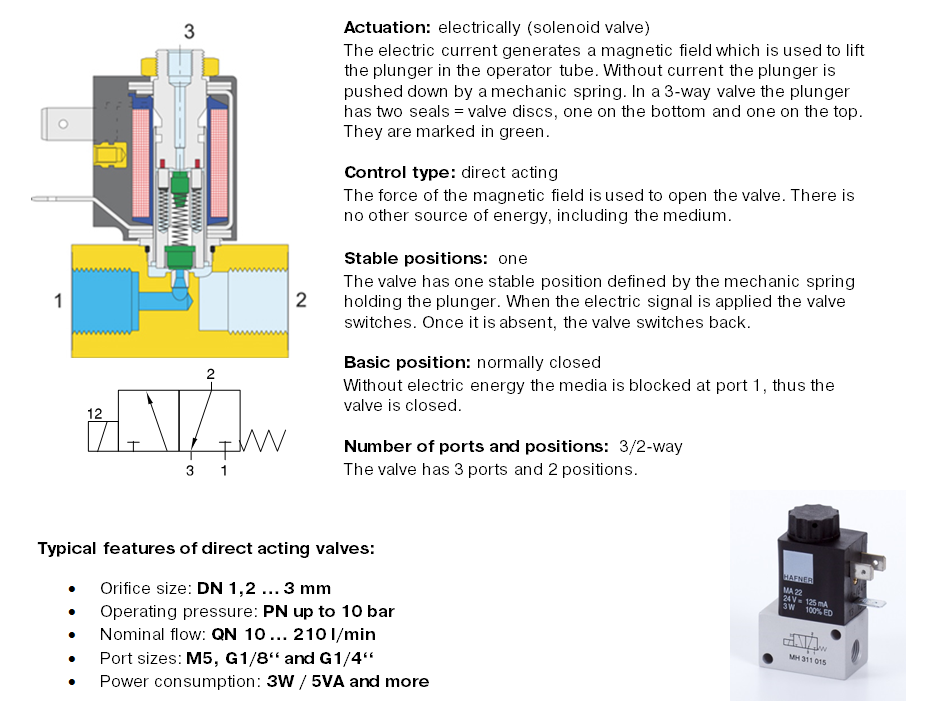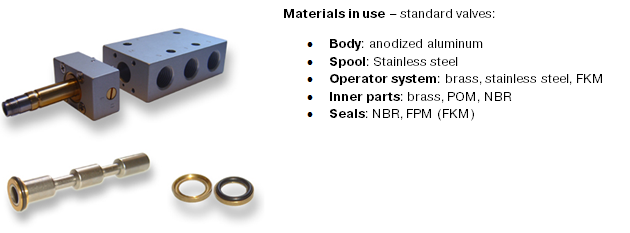Chapter 4 - Structure and function of directional valves
Structure and function of directional valves
1. Structure of direct acting solenoid valves
Direct acting solenoid valves are typically poppet valves. The movement of the valve disk opens and closes the route of the medium.
The graphic below shows the cross section of an electrically actuated direct acting 3/2-way valve.
This type of valve offers a small orifice size at 10 bar. Therefore the flow is relatively low. If a larger orifice size is required, the power consumption increases at the same rate.
Function:
Pressure supply is connected to port 1. The force of the spring pushes the valve disk onto the seat and closes port 1. This force has to be larger than the force of the medium. In basic position the valve is open from port 2 to 3. (This is the normal basic position of a 3/2 way normally closed valve.)
As soon as sufficient electric current is applied to the coil the valve disc is lifted from the valve seat of port 1. Simultaneously a second valve disc closes the seat between ports 2 and 3. Therefore the medium is free to flow between 1 and 2. The route between 2 and 3 is blocked.
As soon as the electric current is absent, the valve switches back into basic position (1 closed, open from 2 to 3).
Important! Direct acting solenoid valves only use the electric energy provided to lift the plunger against the force of the mechanic spring. Therefore this type is mainly used for valves with smaller orifice size. The force of the spring has to be larger than the force of the medium below the seat and the generated force of the coil larger than the one of the spring.
How are direct acting valves with larger orifice sizes designed?
The graph below shows the cross section of an electrically actuated direct acting 2/2-way valve.
2. Structure of pilot operated spool valves
Pilot operated valves (spool valves) consist of 2 parts. The graphic below shows the cross section of a 5/2-way single solenoid valve.
The characteristics of the main valve are:
Basic design: spool valve
The axial movement of the spool opens and closes the route between distinct ports in the valve. This movement is provided by the energy of the compressed air.
Actuation: electrically (solenoid valve)
The pilot valve is electrically actuated. For its function see the explanation above.
Control: piloted
The pilot valve controls the pilot air which is taken from port 1 of the main valve and internally supplied to the pilot valve. Port 2 of the pilot valve is connected to the top of the spool, triggering its movement.
Number of stable positions: one
The valve has one stable position. As soon as the electric signal is absent, the pilot valve exhausts and the spool is pushed into basic position by either a mechanic spring or the force of the medium feed from port 1 of the main valve to the back-end of the spool (called air spring). Sometimes a combination of both types of springs is used.
Basic position: Typically a 5/2-way valve is open from 1 to 2 and from 4 to 5. There is no such thing as “normally closed” or “normally open” for 5-way valves.
Number of ports and positions:
5/2, the valve has 5 ports and 2 positions.
The typical features of Hafner spool valves are:
- Orifice: DN 3 … 18 mm
- Operating pressure: PN 10 bar
- Nominal flow: QN 200 … 6.000 l/min
- Port size: M5 … G3/4“
- Medium: Compressed air
- Power consumption: 3W / 5VA

Spool valves can combine a high flow (large orifice size) at a significant maximum pressure (the standard is around 10 bar, can be larger on request) with a low power consumption.
In order to function correctly, the valves require a minimum pressure. If there is less pressure applied to the valve, the spool might not move. In this case the friction is too high.
Overview of advantages and disadvantages:
|
|
Directly actuated valve Small orifice |
Directly actuated valve Big orifice |
Piloted valve Big orifice |
|
Orifice / Flow |
small |
high |
high |
|
Max. Operating pressure |
high |
low |
high |
|
Min. Operating pressure |
0 |
0 |
> 0 |
|
Power consumption |
small |
high |
small |
We will now introduce you to the function of 5-way solenoid spool valves which are pilot operated and explain the advantages of the Hafner design.
The graph below shows the cross section of a 5/2-way single solenoid pilot valve.
Function of a Hafner 5/2-way single solenoid valve (type: MH 510 / MD 510 / MMD 510)
Pressure is connected to port 1. Through an axial hole in the spool compressed air is fed towards one end of the spool into the end-cap (right side in the drawing), there the air spring is built up. The spool is pushed into basic position. (Generally the valve can also be equipped with a mechanic spring). Simultaneously the pilot valve is supplied with compressed air through the pilot air duct (indicated in blue).
The different sections inside the body of the main valve are separated by seals pressing onto the spool (green).
In basic position air is allowed to flow from 1 to 2. Besides that ports 4 and 5 (exhaust port) are connected.
Port 3 is closed.
The main valve is piloted by a direct acting 3/2-way normally closed poppet valve that is supplied with air from the main valve. As the coil sitting on the operator tube is supplied with sufficient electric current the plunger is lifted. This opens the valve seat in the pilot valve and pilot air is fed to the “left side” of the spool. As the surface of the spool on that side is larger (approximately double) than on the spring side (right) the spool is moving towards the end cap.
Result: The main valve switches. Air connected to port 1 is now free to flow to port 4. Ports 2 and 3 are connected, 5 is closed.
When the current is taken away from the coil, the plunger drops and closing the seat in the pilot valve. Pilot air exhausts through the operator tube. The air spring becomes stronger than the opposite side of the spool and switches the main valve back into basic position.
Special features of Hafner valves with the “swimming O-ring”.
By using high quality materials and modern means of manufacturing we can offer a range of products at high quality and with high reliability.
HAFNER also offers valves made from other materials or for specific applications such as:
- Stainless steel valves
- Brass-free products
- Low temperature valves (to -50°C)
- Poppet valves made from polyamide
- Valves for explosion hazardous environments (ATEX- approved)
Features of the sealing system with the „swimming O-ring“:
There is no deformation of the seal during assemblage of the valve - they are allowed to move independently within the brass cage. Without air pressure there is no contact pressure and, therefore, no friction. This construction also has consequences for the seals of the valves in use. When switching a 5/2-way valve only three of the five seals are exposed to pressure and applying friction to the spool.
Communication of flow rates
The Hafner catalogue contains information about the flow-rates of the valves l/min (liter per minute).
The nominal flow is measured according to standard as follows:
Supply pressure p1=6 bar, back pressure 5 bar
The flow of the air at Δp=1 bar is indicated after expanding the air from 5 to 0 bar in l/min.
Therefore the amount of „expanded“ compressed air is 5 times the volume of the air that is actually flowing.
Important notice!
Some manufacturers communicate the „maximum flow“ at „maximum operating pressure“. This value might be significantly higher. In case you design your pneumatic system for significantly lower pressure than 6 bar you might want to use components with a bigger orifice.
HAFNER Pneumatik offers a very wide range of direct acting poppet valves and pilot operated spool valves with port size M5 to G 3/4” and a nominal flow of up to 6.000 l/min!
In a later chapter we will introduce you to diaphragm valves and other poppet valve designs. Those are mainly used in process industry. In these industries, the medium is often times not compressed air.









